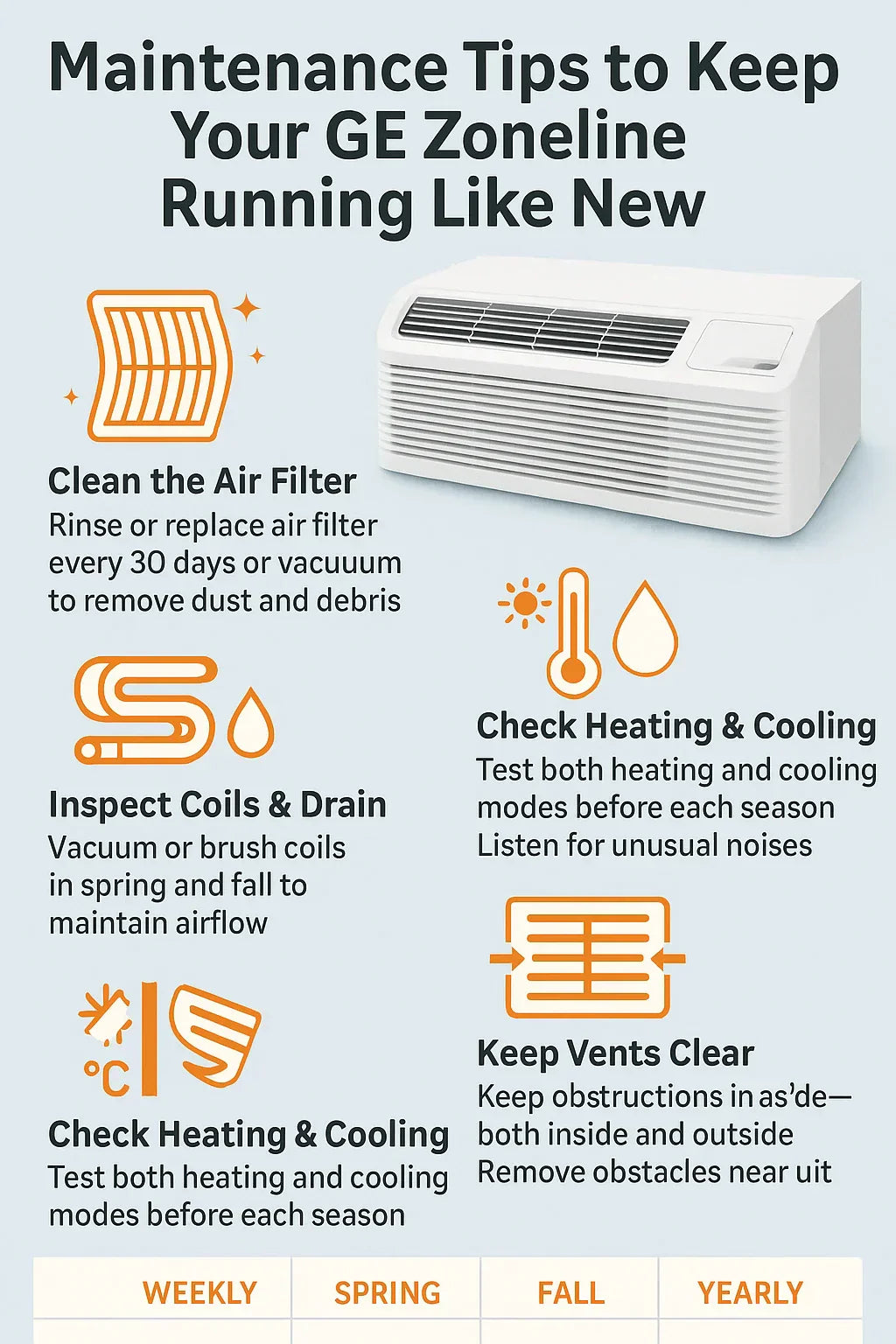The GE Zoneline 15,000 BTU PTAC unit with Heat Pump (Model AZHS15DCXXA) is known for its energy efficiency, quiet operation, and year-round performance. But even the best PTAC units need a little TLC to stay at the top of their game.
Routine maintenance not only keeps your unit operating efficiently—it also extends the lifespan of critical components and ensures your system continues to provide quiet, reliable heating and cooling for years to come.
Here’s everything Savvy homeowners need to know to maintain their GE Zoneline PTAC like a pro.
🚿 Why Maintenance Matters
Regular upkeep directly impacts:
-
Energy efficiency (EER and CEER retention)
-
Air quality and odor control
-
Noise levels from fan and compressor
-
Longevity of internal parts (fan motor, coil, sensors)
Even skipping one season of maintenance can lead to:
-
10–30% efficiency drop
-
Higher electric bills
-
Loud operation
-
Premature wear and tear
🪜 Weekly to Monthly Maintenance Checklist
🪩 Clean or Replace Air Filters
-
Frequency: Every 30 days (more in dusty/pet-prone areas)
-
How: Open front grille, slide out the mesh filter, vacuum or rinse with mild soap
-
Why: Dirty filters block airflow and cause the fan motor to work harder
Tip: Always allow washed filters to air dry completely before reinserting.
🌬️ Check Airflow
-
Ensure vents are not blocked by curtains, furniture, or dust
-
Weak airflow can indicate:
-
Clogged filter
-
Dirty coil
-
Fan malfunction
-
🌟 Seasonal Maintenance (Spring & Fall)
Before summer cooling and winter heating seasons, plan a deeper checkup.
🔧 Clean Coils
-
What: Evaporator (inside) and condenser (back side)
-
How:
-
Remove the front panel
-
Use a coil brush or soft vacuum attachment
-
Avoid bending aluminum fins
-
-
Why: Clean coils transfer heat more efficiently and reduce compressor workload
💧 Inspect Drainage
-
Check the drain pan for standing water or mold
-
Ensure the condensate line is free of debris
-
A clogged drain can cause:
-
Water leaks
-
Musty odors
-
Short cycling
-
🛎️ Tighten Loose Screws or Panels
-
Vibration can loosen mounting brackets and panels
-
Rattling is often fixed with a screwdriver, not a technician
💪 Test Fan Speeds & Thermostat Response
-
Switch through all fan speeds (low, med, high)
-
Check cooling/heating activation at set temps
-
Look for long compressor delays or inconsistent airflow
⚡️ Winter Preparation
❄️ Test Heat Pump Mode
-
Run the unit in heating mode for 15 minutes
-
Ensure warm air is coming out at a steady temp
-
If air is cold: could be a stuck reversing valve or thermostat sensor issue
🔋 Backup Electric Heat Strip Check
-
Heat pump performance drops below 35°F
-
The resistance heater should kick in automatically
-
If it doesn’t: check circuit panel, thermostat control board
☀️ Summer Preparation
🌞 Full Cooling Test
-
Run unit on high for 10+ minutes
-
Use a probe thermometer:
-
Return air temp: 75°F
-
Supply air temp: 55°F
-
-
If difference <15°F: possible refrigerant issue or dirty coils
🏠 Clean Outdoor Grille
-
Dust, leaves, or bird nests can block condenser airflow
-
Wipe grille or vacuum from outside
🛠️ Maintenance That Extends System Life
🔢 Use a Surge Protector
-
Protects against lightning and voltage spikes
-
Ideal for older homes or buildings with outdated wiring
⌚ Schedule Thermostat Operation
-
Reduces unnecessary cycling
-
Protects compressor by allowing adequate off-time
🌳 Seal Wall Sleeve
-
Air leaks reduce efficiency and increase runtime
-
Use weather-sealing foam around sleeve and sleeve-to-unit connection
📅 Keep a Maintenance Log
-
Track filter changes, cleanings, and technician visits
-
Helpful for warranty claims and resale
🔎 Common Signs It’s Time for Maintenance
| Symptom | Likely Cause | Recommended Action |
|---|---|---|
| Weak airflow | Dirty filter or fan issue | Clean filter, check motor |
| Rattling noise | Loose panel or bracket | Tighten screws |
| Musty odor | Standing water or dirty coil | Clean drain pan and coil |
| No heat in winter | Heat pump or strip malfunction | Test backup heat mode |
🔹 Professional Service Recommendations
Call a certified technician once per year to:
-
Test refrigerant charge (if needed)
-
Inspect wiring and sensors
-
Perform deep coil cleaning
-
Check for unusual cycling or compressor noise
Technician visits are especially recommended if:
-
You smell burning or plastic
-
The fan won’t shut off
-
The unit runs but doesn’t heat or cool
✅ Summary: Quick Checklist
| Task | Frequency |
| Clean air filter | Monthly |
| Check drain pan | Seasonal |
| Clean coils | Seasonal |
| Tighten panels | Seasonal |
| Thermostat battery change | Annual |
| Technician inspection | Annual |
📆 Final Verdict: Easy Maintenance for Long-Term Comfort
With just a few minutes per month and seasonal tune-ups, the GE Zoneline PTAC can provide:
-
Efficient heating and cooling
-
Lower electric bills
-
Quiet operation
-
Extended lifespan (10–15+ years)
This PTAC was designed for DIY-friendly care, and with a little attention, you can enjoy reliable performance in every season.
In the next topic we will know more about: Best Wall Sleeves and Thermostats for the GE Zoneline PTAC







